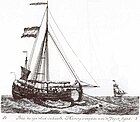Craster kipper
 Craster kippers served with buns | |
| Type | Kipper |
|---|---|
| Place of origin | United Kingdom |
| Region or state | Craster |
Craster kippers are kippers from the Northumberland fishing village of Craster. They have been acclaimed as the best British kipper.[1]
Background
Like the Newmarket sausage or the Stornoway black pudding, the Craster kipper is a British food named after, and strongly associated with, its place of origin. Although the herrings used for Craster kippers may no longer be strictly local,[2] the defining characteristic of the Craster kipper is that the smoking process takes place in a smokehouse located in or around the village of Craster.
Clarissa Dickson Wright has named Craster as the birthplace of the kipper.[3] There is, however, some dispute over this – other places, including the nearby town of Seahouses, also claim this distinction.[citation needed]
Preparation and characteristics
Although a long-standing tradition in Craster, commercial kipper production is currently only continued there by L. Robson & Sons, using their over 100-year-old smokehouses.[4]
The preparation process begins with selected raw North Sea herring, known locally as "silver darlings".[5] These are split, gutted and washed,[6] soaked in brine, and then taken to the smokehouse where they are cured over smouldering oak and white wood shavings for sixteen hours.[7] The famous smokehouse is unmistakable — a stone building often with white plumes pouring out of the wooden vents in the roof.[8]
In appearance a Craster kipper is still recognizably a fish; the head is preserved and, unlike some other kippers which are dyed using annatto, the natural colours of the Craster kipper's skin are tanned golden by the oak smoke.[9] The flesh has a distinctive reddish-brown colour.[10]
Gastronomic properties
It has been said that comparing the Craster kipper with a common commercial processed kipper is like "comparing a fillet steak with a cheap burger",[9] and that "on the tongue, the [Craster] kipper is as delicate, as sophisticated, as the finest smoked salmon in the world and costs but a fraction of the price."[11]
Craster kippers have been described as "the best",[1] although that claim has also been made of other British kippers such as Loch Fyne kippers.[12]
See also
References
- ^ a b "Where to Eat the Best Kippers in the World? | TasteAtlas". www.tasteatlas.com. Retrieved 2022-06-07.
- ^ Winpenny, David (1997). Northumbria Papers (Great Britain Guides). McGraw-Hill. p. 23. ISBN 978-0-8442-4882-0.
Craster oak-smoked kippers are famous, but the fresh fish is brought in from elsewhere
- ^ Dickson Wright, Clarissa (2012). Clarissa's England: A gamely gallop through the English counties. Hodder & Stoughton. ISBN 978-1-444-72909-2.
If you go up the coast further you will come to Craster, the birthplace of the kipper
- ^ Paul Gogarty (28 April 2008). The Coast Road: A 3,000 Mile Journey Round the Edge of England. Anova Books. pp. 194–. ISBN 978-1-905798-09-4. Retrieved 6 December 2012.
- ^ Country Life. Country Life, Limited. May 2002. Retrieved 6 December 2012.
- ^ Bill Griffiths (2006). Stotty 'n' Spice Cake: The Story of North East Cooking. Northumbria University Press. p. 32. ISBN 978-1-904794-13-4. Retrieved 6 December 2012.
- ^ Gemma Hall (18 September 2012). Bradt Slow Northumberland & Durham: Including Newcastle, Hadrian's Wall and the Coast. Bradt Travel Guides. p. 59. ISBN 978-1-84162-433-4. Retrieved 6 December 2012.
- ^ Hall, p. 78
- ^ a b Waitrose Food Illustrated. John Brown Contract Publishing. January 2001. Retrieved 6 December 2012.
- ^ Andrew McCloy; Stephen Whitehorne (30 January 2009). Coastal Walks Around Britain. New Holland Publishers. p. 88. ISBN 978-1-84773-127-2. Retrieved 6 December 2012.[permanent dead link]
- ^ "The Connoisseur". The Connoisseur. 214 (863–868). 1984.
- ^ Lesley Anne Rose; Michael Macaroon; Vivienne Crow (28 November 2011). Frommer's Scotland. John Wiley & Sons. p. 28. ISBN 978-1-119-97259-4. Retrieved 6 December 2012.
External links
- The commercial web site of L. Robson & Sons Ltd (Craster kipper producers)


